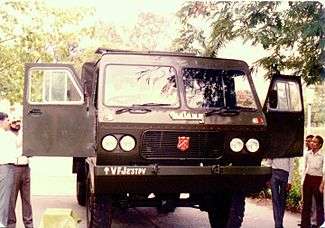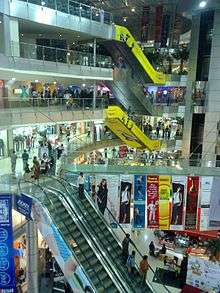Economy of Madhya Pradesh
| Statistics | |
|---|---|
| GDP | ₹7.14 lakh crore (US$110 billion) (2016-17 est.) |
| GDP rank | 9th |
GDP by sector |
Agriculture 37% Industry 21% Services 42% (2015)[1] |
Labour force by occupation |
Agriculture 62% Industry 5% Services 33% (2015) [1] |
| Public finances | |
| 18.89% of GSDP (2016-17 est.)[1] | |
| 3.49% of GSDP (2016-17 est.)[1] | |
| Revenues | ₹1.34 lakh crore (US$20 billion) (2016-17 est.)[1] |
| Expenses | ₹1.59 lakh crore (US$24 billion) (2016-17 est.)[1] |
|
All values, unless otherwise stated, are in US dollars. | |
The economy of Madhya Pradesh was considered as one of the most "sick" economies of India till 2003, after 2005 it registered consistent growth rate and it reached India's top-most state in terms of GDP growth, with a rate of 12% GDP for annual year 2011–12.[2] Madhya Pradesh has received award from Hon'ble President of India - Shri Pranab Mukharjee, in January 2013 for improving its tourism, medical and infrastructural growth. After Gujarat, Madhya Pradesh is now the second preferred state for the corporate world to get their industries set up.
Macro-economic trend
Following is a table showing trend of gross state domestic product of Madhya Pradesh at market prices estimated by Ministry of Statistics and Programme Implementation with figures in millions of Indian Rupees.
| Year | Gross State Domestic Product |
|---|---|
| 1980 | 77,880[3] |
| 1985 | 139,050[3] |
| 1990 | 304,720[3] |
| 1995 | 478,410 |
| 2000 | 737,150 |
| 2005 | 1,044,850[4] |
After partition, the new Madhya Pradesh state produces about 70% of the output of the old Madhya Pradesh state – the rest is produced by Chhattisgarh. The state's debt was estimated at 51 per cent of its GDP by 2005.[5]
Agriculture

This is a chart of output of major commodities of Madhya Pradesh.
| Commodity | National Share |
|---|---|
| Soybeans | 75% |
| Grams | 36% |
| Oilseeds | 25% |
| Pulses | 24% |
| Food grains | 8%
d |
Industry

Until 2005, there was only one S&P CNX 500 conglomerate with its corporate office in Madhya Pradesh viz. Ruchi Soya Industries (2005 gross income Rs 49,661 million). Now there are many big industries having their base in the state. State-run NTPC will invest about Rs 20,000 crore to set up a 3,960-megawatt (Mw) coal-based power project in Madhya Pradesh. NTPC had signed a memorandum of understanding with the state government and MP Power Trading Company regarding this[6]
Madhya Pradesh has 6 Ordnance Factories, 4 of which are located at Jabalpur (Vehicle Factory, Grey Iron Foundry, Gun Carriage Factory, Ordnance Factory Khamaria) and one each at Katni and Itarsi. The factories are run by the Ordnance Factories Board, and manufacture a variety of products for the Indian Armed Forces.
Minor forest produce
MFP from the forests, such as Tendu leaves used to roll bidis, sal seed, teak seed and lak are a major contributor to the rural economy of the state. MFP-PARC (Minor Forest Produce - Processing & Research Centre) is located in the state capital - Bhopal. MFP-PARC is a unit of M P Minor Forest Produce (Trading & Development) Co-operative Federation Limited.[7] "Vindhya Herbals" is the brand of various ayurvedic, herbal & fruit products produced by M P MFP Federation. Apart from MFP-PARC, these products are also produced in Rehti (Sehore District), Barman (Narsinghpur District), Katni, Panna & Dewas in Madhya Pradesh. Some more processing centres are in the pipeline.
Economy of 4 main districts
Bhopal
Bhopal is the capital and the second largest city in the state. Initially the economic growth stalled because of the Bhopal Gas Tragedy but now has started growing again.[8] Its economy is mainly based on Industries. It is an important Industrial center of the state. Electrical goods, cotton, chemicals and flour milling are the main source of economy. Zardaori and embroidery of Bhopal's old city is also famous. The district is highly urbanised with nearly 80% of the population marked as urban. Now being a metropolitan city, many Software/IT sectors companies are setting up offices in the city. Bhopal is also an important tourist place with the following destinations near the city:[9]
- Islamnagar (11 Km away): Palace built by the Bhopal's Afghan rulers
- Bhimbetka rock shelters (45 Km away): Archeological site of the Paleolithic era. A UNESCO World Heritage Site
- Sanchi Stupa (46 Km away): A Buddhist Stupa commissioned by the emperor Ashoka the Great in the 3rd century BC
Gwalior
Gwalior enjoys being at a very strategic position as being a main junction on New Delhi - Chennai railroad and being on NH-3 and NH-75. Gwalior is surrounded by 3 Industrial areas - Sitholi, Banmore and Malanpur. All these three sectors are on NH 75, National Highway 3 and NH 92 respectively. Malanpur is the biggest. The city earlier had big manufacturing industries such as Gwalior Grasim and J.C. MILLS of Birlanagar but now this sector is left with only one industry – J.B.Mangharam Ltd. But the other three sectors have many industries. The important ones are dairy, chemical, manufacturing, and textiles. Handicraft and small industries are also found such as Gwalior potteries. Gwalior is also an important historical and tourism sector of the country therefore tourism sector also puts an effect into the city's economy. Gwalior trade fair is an annual trade fair showcasing economy of Gwalior.
Indore

Indore is commercial capital of Madhya Pradesh with a bulk of its trade coming from large, medium and small scale manufacturing and service industries. These industries range from Automobile to Pharmaceutical and from Software to Retail and from Textile trading to Real estate. Major industrial areas surrounding the city include the Pithampur Special Economic Zone and the Sanwer Industrial belt. Pithampur is also known as the Detroit of India.[22][23] While the Textile manufacturing and Trading is the oldest business to contribute to economy, the Real Estate has emerged very fast in past few years. National Real Estate Players DLF Limited,Omaxe,Sahara, Parsvnath, Ansal API, Emaar MGF have already launched their residential projects in Indore. These projects are generally on the Indore bypass.This road also houses the projects of many local and regional Real estate players like Silver spring, Kalindi, Milan Heights etc. Major software firms in Indore include Worldpay ,Impetus, IBM India[24] and Computer Sciences Corporation (CSC). Also many small and medium size software development firms are also established. In the software front a major event occurred in the first half of 2011 when India's biggest software company Tata Consultancy Services decided to open a campus in Indore. Government of MP has also done the land allotment.[25] Infosys, country’s second largest information technology services company, plans to set up new development centre at Indore at an investment of Rs 100 crore in phase one.[26] Pithampur near Indore houses production plants of various Pharmaceutical companies like Ipca Laboratories, Cipla, Lupin, Glenmark, Unichem.
Jabalpur
The Narmada river bringing in fresh water from the Vindyachal Ranges has developed Jabalpur district into an agrarian economy. The land of the Narmada basin with its fertile alluvial soil gives good yields of sorghum, wheat, rice and millet in the villages around Jabalpur. Important among commercial crops are pulses, oilseeds, cotton, sugar cane and medicinal crops. The state is poised for a breakthrough in soybean cultivation. In Kharif crops occupy 60% and Rabi crops 40% area with 71.4% area under food grain production. Nearly 59% of landholders are marginal whereas small farmers share 18% of farmland. Low literacy rates (35.45%), undulating topography, high percentages of waste land (13.2%), underdeveloped irrigation potential (23%), low ground water utilization, large proportion of rain fed agriculture (75%), practice of Kharif fallows (3.6%), low cropping intensity (131%), low fertilizer consumption (50 kg/ha), high proportion of low value crops, and high numbers of unproductive livestock constrain production in the state. Jabalpur has a variety of industries largely based in mineral substances of economic value found in the district, although the ready-made garments industry is a substantial portion of production in Jabalpur. Defence establishments started in the early 20th century. Jabalpur has Vehicle Factory Jabalpur, Grey Iron Foundry, Gun Carriage Factory Jabalpur and Ordnance Factory Khamaria which belong to the Ordnance Factories Board manufacturing various products for the Indian Armed Forces. The Gun Carriage Factory was started in the year 1904 is well equipped and manufacture gun parts, mounting, shells and a variety of the other product for war purpose. Vehicle Factory Jabalpur (VFJ) was started as manufacturer of trucks and other defence vehicles. Other two are Grey Iron Foundry (GIF) and Ordnance Factory Khamaria (OFK). Armed forces make up a large portion of the city and economy in this city. The city has three regimental centres: Grenadiers, Jammu and Kashmir rifles and the Signals regiment. Jabalpur is also the army headquarters of Madhya Pradesh, Bihar, Chhattisgarh, and Orissa. Jabalpur is an important divisional headquarters, having eight districts: Jabalpur, Seoni, Mandla, Chhindwara, Narsimhapur, Katni, Dindori, Balaghat. The Jabalpur District has been reconstituted on May 25, 1998. It now has four tehsils Jabalpur, Sihora, Patan and Kundam. Jabalpur also has the headquarters of the Madhya Pradesh State Electricity Board, Homeguards and many other state and central government offices. There are seven blocks in the district with 1449 inhabited villages, 60 uninhabited, 1209 revenue villages and 4 forest villages. The presence of several industries in Jabalpur bolstered the industrial scenario of the city. However the industrial growth of the area owes much to the defense establishments and the four ordnance factories. The presence of the military base and the ordnance factories have improved the infrastructure of the city. This has boosted the industrial development of Jabalpur. The important industries in Jabalpur are:
- Readymade garments units
- Poultry/hatchery
- Electrical goods industry
- Sawmills
- Wood cutting industry
- Industries relating to lime stone products
- Building materials
- Glassware
- Telephone parts
- Furniture making industry
- Shaw Wallace Gelatin Factory
- Steel structures works
- Cement industries
- Commercial Engineers & Body Builders Co Limited [CEBBCO ]
- Tobacco business
- Retail business
- Food processing industry
- Vendors for Coca-Cola India & Parle India
References
- 1 2 3 4 5 6 "Madhya Pradesh Budget Analysis 2016-17" (PDF). PRS Legislative Research. Retrieved 19 November 2016.
- ↑ "Madhya Pradesh's GDP goes up to 12 per cent - The Times of India". The Times of India. Retrieved 2016-06-18.
- 1 2 3 includes Chhattisgarh
- ↑ Madhya Pradesh economy soars to $24b by 2005
- ↑ Madhya Pradesh debt estimated at 51 per cent of GDP
- ↑ "NTPC eyes 20K crore thermal plant in MP". business.rediff.com. Retrieved 27 Oct 2010.
- ↑ http://www.mfpfederation.com
- ↑ "Bhopal's economy stalled by 1984 gas leak". BBC. 2009-11-29. Retrieved 2016-06-04.
- ↑ "MPT - Madhya Pradesh Tourisum". www.mptourism.com. Retrieved 2016-06-04.
External links
Jump up ^ http://www.mpsidc.com [1]